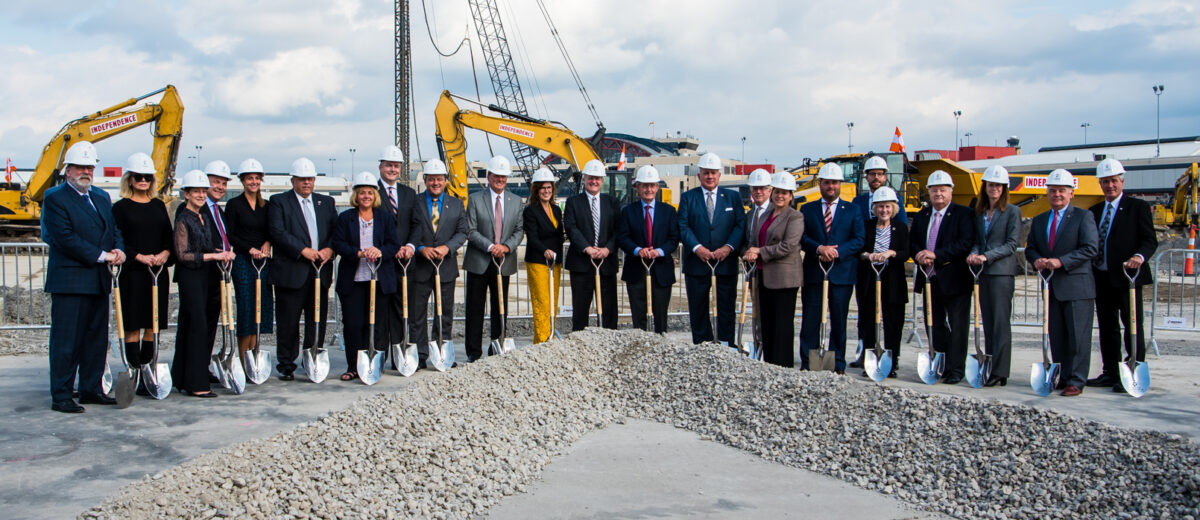
‘Making History Again’: PIT Breaks Ground For Future
Standing before a backdrop of backhoes and cranes arrayed across Pittsburgh International Airport’s west ramp on Thursday, CEO Christina Cassotis made a bold declaration.
“Ninety years ago, Allegheny County Airport opened as the first airport in the nation with full lighting and paved runways. We made aviation history,” she said. “Today at Pittsburgh International Airport, we’re making history again. We’re really breaking ground on this region’s future.”
More than 300 people joined Cassotis at the ceremonial groundbreaking of the airport’s Terminal Modernization Program, a new $1.39 billion terminal intended to “right-size” the airport and focused on public health, sustainability and innovation.
Gathered under a sprawling white tent and sitting in socially distanced chairs on a warm fall afternoon, guests included community partners, elected officials, airline representatives and business leaders.
Cassotis, who runs the Allegheny County Airport Authority, which operates PIT and Allegheny County Airport, was joined onstage by county Executive Rich Fitzgerald, who said the TMP project is emblematic of the region’s progress as a whole.
“We are not the airport of yesterday,” he told the crowd. “We are not the market of yesterday. Airlines and businesses around the world are recognizing the renaissance that continues to evolve here.”
Modernization of the airport involves construction of a new 700,000-square-foot terminal that will include ticketing, security checkpoints and baggage claim. An adjacent complex includes a new 3,300-space parking garage, rental car facilities and new roadways.
Cassotis and other officials stressed the construction project is about more than steel beams and poured concrete, saying the authority has lofty goals for workforce diversity and participation by women- and minority-owned businesses among other efforts to offer equal access to opportunities, Cassotis said.
A unique partnership with OSHA is intended to heighten safety standards at the worksite and a daycare center will be built to help accommodate workers with families, as well.
‘Aviation legacy’
According to an economic impact report created by EBP US Inc., the new terminal, expected to open in 2025, will generate $2.5 billion for the local economy and add some 5,500 local construction and skilled labor jobs, along with 8,500 other jobs. It will generate $27 million in local tax revenue.
David Minnotte, chairman of the airport’s board of directors, said the project makes economic sense for the airport and the community.
“The board recognized the need for quite some time that something needed to be done to address the facility,” he said. “With the groundbreaking today, we continue the region’s aviation legacy with a new terminal that is optimized for the needs of the market and region today while stabilizing costs in the long-term.”
Key design features of the new terminal and parking facilities are centered on elements of nature and sustainability, leading-edge technology and innovation in the community.
Officials are seeking LEED certification at the silver level or beyond for the project, which will require more than 12,000 tons of steel, 94,000 tons of concrete and more than 354,000 square feet of wood materials, much of which the airport hopes to source locally.

But the most important element of the new terminal will be the community that builds it, said Paul Hoback, Chief Development Officer and head of the project.
“To ensure the new terminal embodies the best qualities of the Pittsburgh region, we are engaging area non-profits, foundations and other businesses to partner on various aspects of design and implementation,” he said.
The first U.S. airport terminal to be designed and built post-pandemic, the new facility will incorporate clean air technology and more space for social distancing. It will also feature outdoor terraces—both pre- and post-security—to ensure access to fresh air, a rarity for domestic airports.
During construction, a minimum of 75 percent of waste generated will be recycled or reused, including concrete from existing airfield ramps that will be reused for new roads. Additional plans include rainwater harvesting and other water conservation efforts.
The future of the region depends on thinking about the strength of Pittsburgh’s history and how today’s plans can fuel tomorrow’s prosperity, Cassotis said.
“In Pittsburgh, building is what we do,” she said. “We look around, take stock and say, ‘OK, we think we might be able to do this better.’ And we don’t just make it better for ourselves, we make it better for everybody.”
Recent Comments